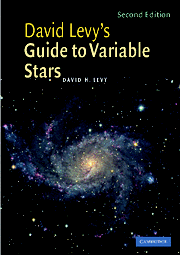Book contents
- Frontmatter
- Contents
- Foreword to the first edition
- Preface
- Acknowledgments
- Part I Getting to know the sky
- Part II Getting to know the variables
- 5 Meeting the family
- 6 Getting started with Cepheids
- 7 Algol, the demon of autumn
- 8 How to estimate a variable
- 9 Names and records
- 10 How your observations help us understand a variable star
- 11 Observing hints
- 12 Observing with CCDs
- 13 Stately and wonderful
- 14 Stars of challenge
- 15 Bright, easy, and interesting
- 16 Betelgeuse: easy and hard
- 17 Not too regular
- 18 Nova? What nova?
- 19 Supernovae
- 20 Clyde Tombaugh's star and the family of cataclysmic variables
- 21 A nova in reverse?
- 22 RU Lupi?
- 23 Orion, the star factory
- 24 Other variable things
- 25 The Sun
- Part III Suggested variables for observation throughout the year
- Part IV A miscellany
- Index
9 - Names and records
from Part II - Getting to know the variables
Published online by Cambridge University Press: 05 August 2012
- Frontmatter
- Contents
- Foreword to the first edition
- Preface
- Acknowledgments
- Part I Getting to know the sky
- Part II Getting to know the variables
- 5 Meeting the family
- 6 Getting started with Cepheids
- 7 Algol, the demon of autumn
- 8 How to estimate a variable
- 9 Names and records
- 10 How your observations help us understand a variable star
- 11 Observing hints
- 12 Observing with CCDs
- 13 Stately and wonderful
- 14 Stars of challenge
- 15 Bright, easy, and interesting
- 16 Betelgeuse: easy and hard
- 17 Not too regular
- 18 Nova? What nova?
- 19 Supernovae
- 20 Clyde Tombaugh's star and the family of cataclysmic variables
- 21 A nova in reverse?
- 22 RU Lupi?
- 23 Orion, the star factory
- 24 Other variable things
- 25 The Sun
- Part III Suggested variables for observation throughout the year
- Part IV A miscellany
- Index
Summary
As the number and quality of your observations grows, your need to record them accurately and efficiently also becomes apparent. Since the recording procedure aids the accuracy of your observations, I suggest that you record your observations in a way that is designed to prevent your being influenced by previous observations.
First, record your data in an observing log that contains the results for each night's observing session. This record may well contain information about all the observing you do, including the Moon and planets, double stars and galaxies, even the Sun. Begin with the date, times, observing site, weather conditions, seeing, quality of the sky, and instrument used. Then list each star that you observed during the night, by name, time, and magnitude estimate. Use a permanently bound notebook or a computerized file, not a spiral or ring binder that will fall apart before it is of use to someone else.
The second step begins after your session is over, when you transfer your data to a special file for each star. File each variable in its own file, keeping them in the order of variable-star designation, and you will find the compilation of your monthly observing report an easy operation. Several generations of variable star observers have found index cards or sheets of paper appropriate, but now computer programs handle these records more quickly. Remember not to take your cards or data files outside with you, lest their listing of your last observation influence your newest observation.
- Type
- Chapter
- Information
- David Levy's Guide to Variable Stars , pp. 44 - 48Publisher: Cambridge University PressPrint publication year: 2005

